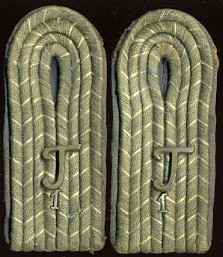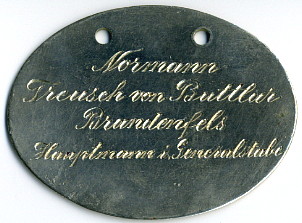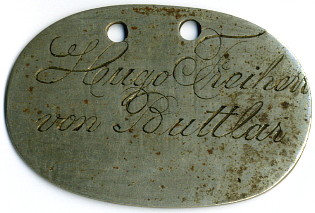-
Posts
2,962 -
Joined
-
Last visited
Content Type
Profiles
Forums
Blogs
Gallery
Events
Store
Posts posted by Chip
-
-
Chris,
I have seen one at least once before on Ebay. I think I might have printed out the results. If I can find it, I will post the information here.
Chip
0 -
Paul,
The F?silier Rgt. Nr.40 would have adopted white as the backing color in 1915, but epaulettes and the epaulette bridals were abolished at the same time, so these epaulettes are confusing to me. Prior to September 1915 the shoulder straps of F.R.40. were Hellblau (a medium blue). The cuff Patten for the regiments of the XIV Army Corps had no piping. There was no official "transitional" Dunkelblau tunic, though we know from photographic evidence that these uniforms were worn at home in Germany up until the end of the war. I rather doubt that new blue uniforms were being made after 1915. So at best, this has to be a pre-1916 made tunic, which would not be correct for F.R.40. I would really appreciate it if someone would explain the epaulettes to me. I must be missing something, as they appear to be OK from what I can see.
Chip
0 -
Very interesting to me-- he has chosen the expense of buying a single Bavarian style ribbon bar for his EK2... rather than just wearing it in his buttonhole!
What buttonhole!

Here are what a pair officer's boards from the same unit look like. The Bavarians used the Prussian style "T" until 1918 when they changed to this rather plain "T" design for the officer's insignia. These are the only examples that I have seen of this pattern and Robert's photo is the first I have seen of it being worn.
Chip

 0
0 -
Mike,
No, I am not saying that at all. The canteen is definitely German. It is hard to tell about the cover with such a photo. The fact that it was used by a reenactor gives it that worn look. Most things like this can only be judged by a first-hand inspection.
Chip
0 -
Hun Helmet,
The cover looks as if it might have had a button for attaching the stopper strap. If that is the case, the cover is for the 1917 pattern canteen. The canteen itself was unchanged from the M1915. Only the cover was altered in order to use less leather than the 1915 pattern which had a longer strap.
Chip
0 -
Christian,
They look like the 1866 pattern boards, but there is not much reference about them. I'm sure that the "C" was still being used at that early time, but later became a "K". The colors look Hessian. This is all just pure speculation. Perhaps others have more details about the possibilities from that era (pre 1888).
Chip
0 -
Dave,
I think you are right. I never even considered that the cuffs would be rolled under from the bottom. The bayonet knot appears to have different colored slider ball and crown. These are usually the same color with the exception of the Unteroffizier-Schulen and the Kadettenanstalt.
Chip
0 -
I don't believe that both boys are wearing the same tunic. If anything, the smaller boy would have to roll the cuffs up higher and his are lower. I think the odd bayonet frog would be more indicative of a school, like Rick suggests.
Chip
0 -
And another from a younger generation in the family's traditional occupation.
Chip

 0
0 -
Here's an early Erkennungsmarke from a relative.
Chip

 0
0 -
Tony,
I don't think that there is any way to get the corrosion off of these zinc disks without doing damage. Best bet is just to try to stop the further deterioration. I wash them with a mild dish soap (like Dawn, which has degreasing properties), then let them dry. When dry, I coat them with Vaseline and then wipe the excess off. This darkens them up a little bit and the non-sticky film helps to keep further moisture out.
Chip
0 -
dphillipsd,
It was the 185th division, not the 195th and the change from the 16th Reserve division was made in August of 1916.
Chip
0 -
Mike,
The canteen looks fine. When you get it, there is a good chance that you will find some marking on it. These were often marked either with an ink stamp or a brazed-on piece of metal with the manufacturer's name and a date.
Chip
0 -
Well, he appears to be have the pre-1894 marksmanship lace on his cuff. His NCO knot is also interesting and though it is hard to tell, it looks like an Oberj?ger knot. Could this be a Hirschf?nger that he is wearing?
Chip
0 -
dphillipsd,
I suppose that someone has already told you this, but assuming that your relative was with the regiment on the 28th of March 1918, it is logical to assume that he was one of the many casualties suffered on that day, when all three regiments of the division (185.Div.) attacked. They were in the area of Monchy le Preux (southeast of Arras).
Chip
0 -
Rick,
Great research as always, but more notably, a story told with much craft and humor. What impresses me is the breadth of knowledge of history and language, put together in a most artful manner. Great reading!

Chip
0 -
Rick,
Brandenburgisches J?ger Bataillon Nr.3
Chip
0 -
Well, ET64 would be the correct maker mark for such a helmet. The details of the rim crimping and the arcs of the curves are the real tell-tale signs. It's best to compare against known original pieces. From what I can see in the pictures, it appears to be an original. In addition to that, I might say that it would take some long time or effort to create such an even, deep rusting over the entire helmet. Seems like a lot of trouble for a faker to go to just to produce a rusty shell.
Chip
0 -
This is patterned after one of the most common (of the scarcer Bosnian Kappeabzeichen) Austro-Hungarian cap insignia/fund raiser pins. There was a design for each of the Bosnian regiments.
Chip
0 -
Daniel,
Interesting design. I have never run across one to buy and I have no idea what the price range for the various Belgian made flare pistols is. I suspect, due to the relative numbers when compared to a Hebel model, they are commensurately more expensive. There's a nice article on these and other German flare pistols in the "Gazette des armes" No.149 from January 1986, though you have given us a more in-depth look at this model's workings.
Nice going!
Chip
0 -
Hauptman,
Well, if you want some info about the cap, I can tell you that it was worn either by an enlisted artillery man (foot or field artillery) or someone in the Verkehrstruppen (technical branch), which would include, Flieger-, Eisenbahn-, Kraftfahr-, Telegraphen-, Pioniertruppen. The markings indicate that the cap was reworked (or just cleaned up) at the Prussian Bekleidungs Jnstandsetzungs Amt (B.J.A.) of the VIII Armeekorps, a kind of recycling station. Given the lack of earlier markings in the lining, I would guess that it was probably the replaced part. It might have evidence of other repairs. The"ga" is a Garnitur (clothing condition use status) marking meaning "garnisonbrauchbare" or a better condition suitable for garrison wear . I'm not sure about the other "G", but someone else will be able to tell you. Hope this helps.
Chip
0 -
Hauptman,
All nice items and I especially like that cap! Thanks for showing them.
Chip
0 -
Rosenberg,
Well, that appears to be the correct officer's style eagle. I don't see anything but the Reichskokarde in your photos posted here. What are these other people refering to? Sending you a PM regarding what I found out.
Chip
0 -
Rick,
OK, what is "imperial double time"? I assume it means he got extra credit for some service in order to get a 25 year medal, without being in the army in 1897. Was he a reservist with an official's job the rest of the year? Still learning.
Chip
0




POWs under the care of the Redcross - what nation ?
in Germany: Imperial: Rick (Research) Lundstrom Forum for Documentation and Photographs
Posted
All of the prisoners appear to be French to me, at least that is what the uniforms and caps say. Yser caps had no chinstraps and had buttons in the front. I don't see anything in this photo that would date it any later than 1915.